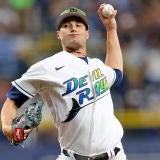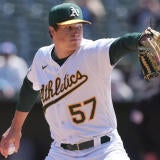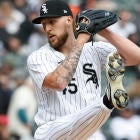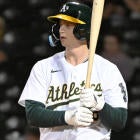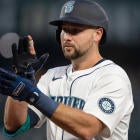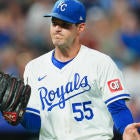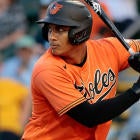Hot stove season is here, and rumors are running rampant. Soon, the moves will begin pouring in, and it'll fall on us to make sense of them all.
By "us," I mean, well, everyone, but especially Chris Towers and I, two Fantasy Baseball gurus guiding you through the transactions of actual consequence for Fantasy Baseball. You've landed in the place where we'll react to them as they happen, breaking down what they mean for 2025 drafts.
You'll notice not much has happened yet. It's been a pretty slow start to an offseason that could see players like Juan Soto, Corbin Burnes, Pete Alonso, and Garrett Crochet change hands. Once the dominoes begin to fall, though, you'll be glad you have one stop for keeping track of them all.
So bookmark this page and keep checking back. You never know what move could reshape your entire draft plan.
The three-year, $63 million deal is a modest one for a pitcher who seemed to have real momentum heading into the offseason, having just put together a 2.70 ERA, 0.93 WHIP and 11.4 K/9 in his 10 starts for the Astros. The improved performance coincided with Kikuchi roughly doubling his slider usage, and his 2025 destination matters less for his Fantasy value than whether or not he sticks to that approach.
He has always missed bats at a good rate but has gotten inconsistent results due to questionable pitch selection and a penchant for hard contact. Going to the Angels gives him a lower margin for error than if he had gone to a true contender and also does nothing to soften his vulnerability to the long ball, but again, his success is tied more to continuing his slider-heavy approach. And for that, we'll just have to wait and see. I cautiously rank him just inside my top 50 starting pitchers for 2025, but he has the upside for more. --Scott White
Unfortunately, this trade is close to a worse-case scenario for the two major players involved. India goes from the most favorable park for home runs -- i.e., one of the few where his fringy power plays -- to one of the least favorable. According to Statcast, his 63 career home runs would be 42 if he played every game at Kauffman Stadium. Obviously, the reverse move is bad for Singer, a pitcher who's on the more pitch-to-contact side of the ledger, but since he generally puts the ball on the ground, maybe it's not as bad. Then again, he has a career 3.92 ERA at home in Kauffman Stadium compared to a 4.74 ERA everywhere else.
Neither India nor Singer figured to be a hot commodity prior to this trade, and both might go undrafted now in shallower leagues. India is a little more useful in points leagues because of his on-base skills, and both he and Singer at least stand to be high-volume plays. India's removal does free up some of the Reds' infield logjam with Matt McLain expected back, penciling in Noelvi Marte at third base again. --Scott White
Rather than test the free agent market, Martinez accepted the Reds' qualifying offer of $21.05 million, which isn't altogether surprising given that it now represents roughly 40 percent of his career MLB earnings. That the Reds extended the offer is telling. They had a front-row seat to the 34-year-old's career season and bought in hard at an amount that virtually guarantees he'll be a full-time starter rather than reverting to a swingman role.
Perhaps, then, we should take Martinez just as seriously. He's always had a killer changeup, and he became a strike-thrower of the highest order in 2024, boasting the third-best walk rate among pitchers with at least 100 innings. His home run prevention was probably too good to be true, particularly for pitching half his games in Cincinnati, but he won't be priced for another 3.10 ERA. More likely, he'll be sort of a poor man's Jose Berrios or Zach Eflin, good for piling up innings with a low WHIP, and he takes on added value in Head-to-Head points leagues due to his relief pitcher eligibility. --Scott White
Finally freed of his catching tandem with Sean Murphy, d'Arnaud was quick to put himself in another one, this time with up-and-comer Logan O'Hoppe. It's frustrating for a couple reasons, one being that O'Hoppe loses some of the volume that made him so attractive for Fantasy, likely going from a 75 percent workload share to 60 percent or less, and the other being that d'Arnaud himself could have pursued a full-time role. Instead, d'Arnaud figures to remain a fringe second catcher for two-catcher leagues, and while O'Hoppe doesn't necessarily slide down the rankings -- he was already regarded as a low-end No. 1 -- his upside takes a hit. Maybe his .196 batting average in the second half is evidence he was overworked, but even if it improves, his counting stats will be capped.
Meanwhile, Murphy has a golden opportunity to reestablish himself in Atlanta after bombing for the past season-and-a-half there. Injuries have likely contributed to his struggles, as has irregular playing time due to the presence of d'Arnaud, but he'll need to prove himself quickly to hold off prospect Drake Baldwin. --Scott White
Only three months after acquiring him from the Giants, the Braves flipped Soler to the Angels in what was essentially a salary dump. They ended up non-tendering the player they got back in the deal, Griffin Canning. You might think Soler's departure reflects well on Ronald Acuna's recovery from a torn ACL, but GM Alex Anthopoulos later confessed that the star outfielder likely won't be ready for the start of 2025. As for Soler, he has an easy claim to the Angels' DH spot and will play in a pretty nice venue, particularly for home runs, but his success has never depended on such factors. He's a mercurial performer coming off a down season but still has the 35-homer upside to pay off handsomely as a fourth or fifth outfielder. --Scott White














